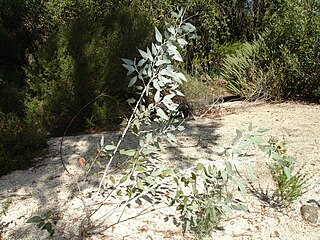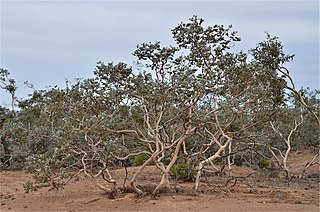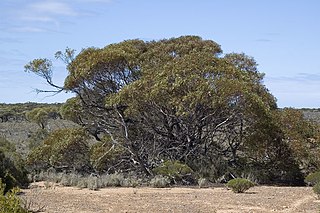
Eucalyptus lansdowneana, commonly known as the crimson mallee or the red-flowered mallee box, is a species of slender stemmed, straggly mallee that is endemic to a restricted area of South Australia. It has rough, fibrous or flaky bark at the base, smooth, grey over creamy-white bark, lance-shaped adult leaves, flower buds in groups of seven, crimson flowers and barrel-shaped fruit.

Eucalyptus cretata, commonly known as Darke Peak mallee or chalky mallee, is a species of mallee or, rarely, a small, straggly tree and is endemic to a restricted part of South Australia. It has smooth whitish and grey bark, lance-shaped adult leaves, glaucous flower buds in groups of seven, white flowers and cup-shaped to barrel-shaped or conical fruit.

Eucalyptus gillii, known as the curly mallee, Arkaroola mallee, or silver mallee, is a species of mallee or small tree that is endemic to inland Australia. It has smooth bark, sometimes with rough bark near the base, often only juvenile, usually glaucous leaves in the crown, flower buds in groups of between seven and eleven, pale yellow flowers and barrel-shaped or shortened spherical fruit.

Eucalyptus albopurpurea, commonly known as the purple-flowered mallee box or Port Lincoln mallee, is a mallee or sometimes a tree that is endemic to South Australia. It has loose, fibrous grey-brown bark on the lower park of the trunk and smooth grey bark that is shed in strips on its upper parts. The leaves are lance-shaped to egg-shaped, the flower buds are spindle-shaped to club-shaped and the flowers are white, pink, mauve or purple. Flowering can occur in most months and the fruit are cup-shaped or barrel-shaped capsules.
Eucalyptus vicina, commonly known as the Manara Hills red gum, is a species of mallee in the family Myrtaceae and is endemic to western New South Wales. It has smooth bark, lance-shaped to curved adult leaves, flower buds in groups of seven, white flowers and cup-shaped or hemispherical fruit.
Eucalyptus gypsophila, also known as the kopi mallee, is a species of mallee that is native to Western Australia and South Australia. It has rough, flaky bark on the lower part of the trunk, smooth light grey bark above, lance-shaped adult leaves, flower buds mostly in groups of between seven and eleven, creamy white flowers and conical to cylindrical fruit.

Eucalyptus kessellii, commonly known as Jerdacuttup mallee, is a species of mallee that is endemic to an area along the south coast of Western Australia. It has very hard, rough bark on the trunk of larger specimens, smooth greyish and brownish bark above, lance-shaped to egg-shaped adult leaves, flower buds in groups of three or seven, creamy white flowers and downturned, conical to cup-shaped fruit.
Eucalyptus repullulans, commonly known as chrysoprase mallee, is a species of mallee that is native to arid parts of Western Australia and the far north-west of South Australia. It has smooth bark, lance-shaped adult leaves, flower buds in groups of between seven and thirteen, cream-coloured flowers and cup-shaped, cylindrical or conical fruit.

Eucalyptus yalatensis, commonly known as the Yalata mallee, is a species of mallee or a shrub that is endemic to southern Australia. It has rough, fibrous or flaky bark on the stems, smooth bark above, lance-shaped adult leaves, flower buds mostly in groups of nine, creamy white or yellowish flowers and hemispherical to shortened spherical fruit.
Eucalyptus wyolensis, commonly known as the Wyola mallee, is a species of mallee that is endemic to South Australia. It has rough bark on the base of the stems, smooth grey to brown bark above, heart-shaped to egg-shaped adult leaves arranged in opposite pairs, flower buds in groups of seven to eleven, pale yellow flowers and cup-shaped to barrel-shaped fruit.
Eucalyptus conveniens is a species of small mallee or shrub that is endemic to a small area on the west coast of Western Australia. It has smooth bark, sometimes with a short stocking of rough bark near its base, lance-shaped to egg-shaped or elliptic adult leaves, flowers buds in groups of three, whitish flowers and glaucous, barrel-shaped fruit.

Eucalyptus extrica, commonly known as eastern tallerack, is a species of mallee that is endemic to Western Australia. It has smooth bark, lance-shaped adult leaves arranged in opposite pairs, flower buds in groups of three, whitish flowers and cylindrical to barrel-shaped fruit.
Eucalyptus tephrodes is a species of small tree or mallee that is endemic to Western Australia. It has rough bark on the trunk and larger branches, smooth bark above, egg-shaped to lance-shaped adult leaves, flower buds in groups of three on the ends of branchlets and cup-shaped to hemispherical fruit.

Eucalyptus alatissima is a mallee that is endemic to central parts of the Great Victoria Desert. It has rough bark on the lower part of its stems, smooth tan to cream-coloured bark on its upper parts, egg-shaped to lance-shaped leaves and buds in groups of three. The buds have a powdery covering and are prominently winged.
Eucalyptus × balanopelex is a mallee that is endemic to a small area of the south-west of Western Australia. It has smooth bark, broadly lance-shaped adult leaves, flower buds in groups of seven, creamy-white flowers and hemispherical fruit. It is thought to be a hybrid between E. kessellii subsp. eugnosta and E. semiglobosa.

Eucalyptus canescens, commonly known as the Ooldea Range mallee or Beadell's mallee, depending on subspecies, is a species of mallee that is endemic to southern Australia. It has rough bark from the base of the trunk to the thicker branches, smooth bark on the thin branches, egg-shaped to lance-shaped adult leaves, flower buds in groups of between seven and eleven, creamy white flowers and smooth cup-shaped to conical, and sometimes ribbed fruit.
Eucalyptus capitanea, commonly known as the desert ridge-fruited mallee, is a species of mallee that is endemic to South Australia. It often has rough, flaky bark on the lower part of the trunk, smooth bark above, lance-shaped adult leaves, ribbed, oval flower buds in groups of seven, cream-coloured flowers and ribbed, urn-shaped fruit.
Eucalyptus hypolaena is a species of tree or mallee that is endemic to Western Australia. It has hard, dark grey bark near the base of the trunk, smooth bark above, lance-shaped adult leaves, flower buds arranged in groups of seven, pale yellow flowers and shortened spherical to barrel-shaped fruit.
Eucalyptus infracorticata is a species of mallee that is endemic to a small area of Western Australia. It has rough, flaky or fibrous bark on the lower part of the trunk, broad lance-shaped adult leaves, flower buds in groups of between seven and eleven and short cylindrical fruit.

Eucalyptus socialis subsp. eucentrica, commonly known as the inland red mallee, is a subspecies of mallee that is endemic to inland Australia. It usually has rough bark on the base of the trunk, smooth bark above, lance-shaped adult leaves, flower buds in groups of between seven and eleven, pale creamy yellow flowers and barrel-shaped to urn-shaped or spherical fruit.









